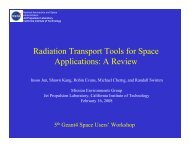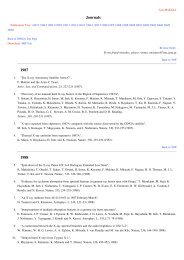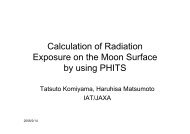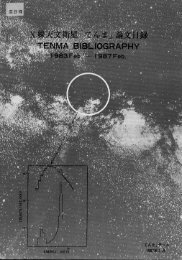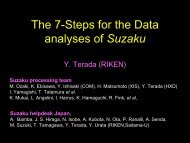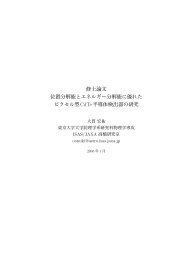2006-34: The X-ray Telescope onboard Suzaku - HEASARC - NASA
2006-34: The X-ray Telescope onboard Suzaku - HEASARC - NASA
2006-34: The X-ray Telescope onboard Suzaku - HEASARC - NASA
Create successful ePaper yourself
Turn your PDF publications into a flip-book with our unique Google optimized e-Paper software.
the case of the <strong>Suzaku</strong> XRT, this results in the Half-Power Diameter (HPD) of ∼18 ′′ .Since ASCA, improvement have been made in three areas. First, the incident grazingangle has been reduced to be < ∼ 0.◦ 6 so that even the outermost mirror shell can reflect the ironK photons. <strong>The</strong> diameter of the X-<strong>ray</strong> telescope has increased from ∼350 mm to ∼400 mm.Accordingly, the focal lengths are extended to 4.50 m and 4.75 m, compared with that of 3.5 mfor ASCA. Second, the smoothness of the ASCA reflectors was achieved by coating the acryliclacquer on the rolled aluminum substrate followed by vacuum deposition of a gold layer on topof it. However, there remains a mid frequency figure error on the surface of the lacquer, whichresults in image broadening. We therefore have adopted the replica method for producing the<strong>Suzaku</strong> reflectors (Serlemitsos & Soong 1996). In this method, the gold layer is sputtered ontoa glass tube of highly smooth surface and is transferred to a reflector substrate with epoxyas adhesive. This improves the HPD from ∼3. ′ 6 for ASCA to ∼1. ′ 9 for <strong>Suzaku</strong>. Finally, sincethe reflectors are tightly packed in the mirror housing, X-<strong>ray</strong>s arriving from outside the fieldof view can be reflected by adjacent surfaces or skip the normal reflections and then appearas X-<strong>ray</strong> images in the field of view. In order to avoid such st<strong>ray</strong> light, we have provided apre-collimator on top of each XRT (Mori et al. 2005). We install five XRT modules on the topplate of the Extensible Optical Bench (EOB). One is referred to as the XRT-S which has a focallength of 4.50 m and was adapted to the X-Ray Spectrometer (XRS; X-<strong>ray</strong> micro-calorimeter;Kelley et al. (<strong>2006</strong>)). <strong>The</strong> other four modules are designated as XRT-I0, I1, I2, I3 with a focallength of 4.75 m, and are dedicated for the X-<strong>ray</strong> Imaging Spectrometer (XIS; X-<strong>ray</strong> CCDcamera; Koyama et al. (<strong>2006</strong>)). Since <strong>Suzaku</strong> is the revival mission of Astro-E1, which failedto reach orbit on 2000 February 10 (Inoue 2003), the basic design and performance verified inthe ground-based calibration have already been published (Kunieda et al. 2001; Shibata et al.2001; Misaki et al. 2005).In this paper, we present first the design parameters of the <strong>Suzaku</strong> XRT in section 2.<strong>The</strong> expected performance on the basis of the ground-based calibration is also described. Insection 3, characteristics of the <strong>Suzaku</strong> XRTs such as effective area, imaging capability, andvignetting, are summarized based on in-flight data. A summary is provided in section 4.2. Design Parameters and Expected Performance from Ground Measurements2.1. <strong>Telescope</strong> Design<strong>The</strong> design parameters of the X-<strong>ray</strong> telescope <strong>onboard</strong> Astro-E1 launched on 2000February 10 are described in full detail in Kunieda et al. (2001). <strong>The</strong> basic telescope design of<strong>Suzaku</strong> has not been changed since Astro-E1, except for the pre-collimator newly adopted for<strong>Suzaku</strong>. <strong>The</strong> reader is referred to this paper for more details on the <strong>Suzaku</strong> XRT.In table 1, we summarize all the design parameters of the <strong>Suzaku</strong> XRT. <strong>The</strong> primaryconstraint on the size of the XRT originates from the maximum possible focal length, which3



